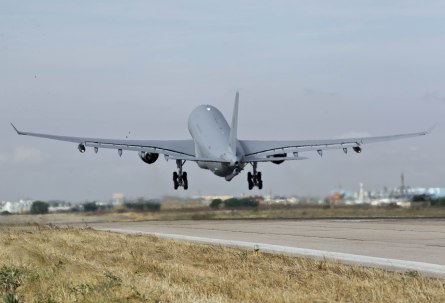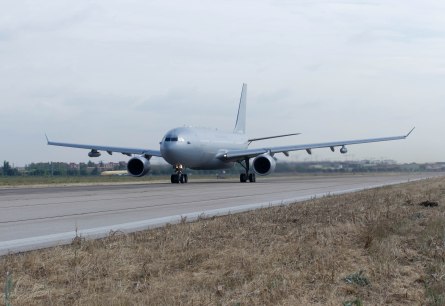The Royal Australian Air Force is about to take delivery of its first Airbus Military A330 multi-role tanker transport after the aircraft departed on its ferry flight from Madrid at 10.00 local time on 27 May.
Designated the KC-30A in RAAF service, the aircraft is scheduled to arrive at RAAF Base Amberley, Queensland on Monday 30 May. It will transit via McCarran airport in Nevada and Hickam AFB in Hawaii.
The news marks the beginning of the end of a long and troubled development saga for the KC-30A, which was originally due to be delivered in 2009. The delays resulted in a tanker gap for the RAAF, obliging it to rely on tankers operated by allies and by private tanker contractor Omega Refueling Services.
 |
|---|
© Airbus Military |
The General Electric CF6-80E-powered aircraft is the second converted by Qantas Defence Services in Brisbane. It was returned to Airbus Military's Madrid site for painting and finishing. It will be joined by the second tanker for the RAAF in June, and two further aircraft later in the year.
The fifth and final aircraft ordered by the RAAF, which arrived in Brisbane for conversion a few days ago, will be delivered next year.
In RAAF service, the A330 MRTT will be equipped with two underwing refuelling pods, the fly-by-wire Airbus Military aerial refuelling boom system and a universal aerial refuelling receptacle slipway installation, enabling it to be refuelled from another tanker. It also has 270 passenger seats.
 |
|---|
© Airbus Military |
The first aircraft to have been converted is having instrumentation removed by Iberia Maintenance following the completion of flight-test activities. It will then have a new air refuelling boom system installed, to replace the one which was lost during a training mishap involving a Portuguese air force Lockheed Martin F-16 in January. Delivery of this aircraft could occur toward the end of this year.
Airbus Military officials speaking at Getafe, Spain on 18 May refused to reveal full details of the January incident, but said it was the result of human error and that "the boom was not out of the [flight] envelope". A human/machine interface modification that adds a stick-shaker function to the boom operator's controls will give "better feedback" in the future, it said. The enhancement was certificated on 29 April, but has not been requested by the Australian customer.
Source: Flight International























